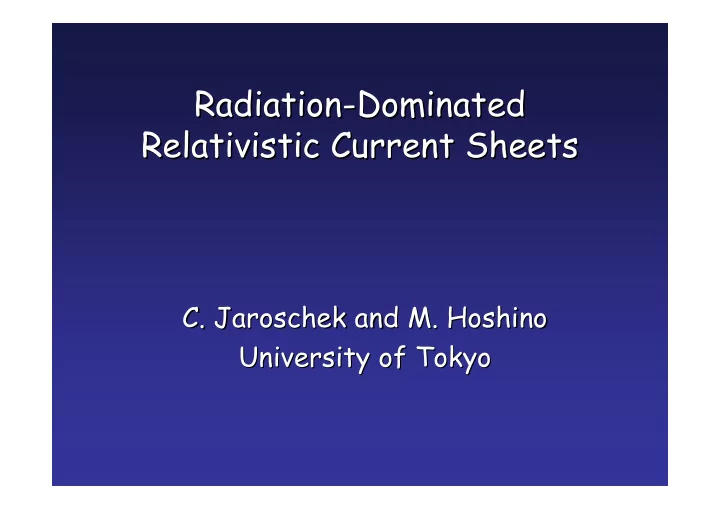

Radiation- -Dominated Dominated Radiation Relativistic Current Sheets Relativistic Current Sheets C. Jaroschek Jaroschek and and M. Hoshino M. Hoshino C. University of Tokyo University of Tokyo
Relativistic Current Sheet Instabilities V A ~ c, T/mc 2 > 1, Electron and Positron Plasmas RMR RDK 10 0 Magnetic Energy Dissipation Rate ( c ) Z 10 -1 MRX Y Z 10 -2 DK-mode X Reconnection Mode Drift Kink Mode 10 -3 10 -2 10 -1 10 0 10 1 10 2 T 0 /mc 2
Open issue for relativistic Current Sheet • radiation effect such as synchrotron cooling 2 2 14 10 10 G 1 10 16 loss 2 B E / mc 10 14 dyn dyn c 10 12 10 10 e.g. Magnetor, acc c =1 10 8 Pulsar magnetosphere,… 10 6 acc c =10 2 10 4 10 2 10 0 10 -2 10 0 10 1 10 2 10 3 10 4 10 5 10 6 10 7 10 8 E/m e c 2
Synchrotron Radiation Effect Without radiation loss N( ε ) ε With radiation loss N( ε ) Synchrotron Loss P Fast Reconnection ε
Radiation Loss Effect in PIC Simulation Code Abraham-Lorentz Formula for Radiation Drag Force
Radiation Loss Effect in PIC Simulation Code Abraham-Lorentz Formula for Radiation Drag Force τ 0 : Light crossing time over classical electron radius (e^2/mc^2)/c ~ 10^ ‐ 23 s Main Radiation Effect is Synchrotron Radiation (cf. Noguchi et al. 2005)
Time Evolution of MR & DKI No Radiation Loss Intermediate Dominant Radiation Loss α =0 α =10 -12 α =10 -11 Tearing Drift-Kink
Growth Curves α : radiation loss coefficient ( α =0 : No radiation loss, α =10 -10 : Strong radiation loss) Tearing Mode (Reconnection) Drift-Kink Mode
Comparison of Growth Rate Relativistic Tearing Mode Super-Fast Reconnection Normalized Growth Rate Relativistic Drift-Kind Mode weak strong (radiation cooling)
Reason for Fast Growth • Decrease of gas pressure by radiation loss • Shrink of plasma sheet & thin plasma sheet Why reconnection has super-fast growth? • Temperature Anisotropy T // ≠ T ⊥
Temperature Anisotropy (Early Stage) 3 3 X 0 Y -3 3 3 0 synchrotron cooling synchrotron cooling -3 3 3 0 -3 large T ⊥ -3 -2 -1 1 2 3 0
Linear Growth Rate ( Γ ) under Temperature Anisotropy • Tearing Mode – strong dependence on T ⊥ /T // (e.g. Chen et al., 1984) – T ⊥ > T // Γ increase – T ⊥ < T // Γ decrease T ⊥ /T // isotropization • Drift-Kink Mode – weak dependence on T ⊥ /T //
Late Nonlinear Stage α =0 α =10 -12 α =10 -11 Tearing Drift-Kink
Temperature Anisotropy in Late Nonlinear Stage X Y Y Y Y T ⊥ < T // reconnection suppressed, shifted to small k mode 2 -3 -2 -1 0 1 3
Relativistic Reconnection under Synchrotron Cooling Initial State T ⊥ > T // Early λ Stage k λ ~O(1) k -1 Late T ⊥ < T // Stage k λ <<1 Sweet-Parker-Type
Summary • Relativistic Reconnection with Radiation Cooling – thin current sheet due to radiation cooling – fast growth of reconnection/drift-kink instability • Nonlinear Evolution of Reconnection/Drift-Kink – Early Stage: T ⊥ > T // • Super-Fast Reconnection • Fast Drift-Kink Instability (weak effect of Temp. Anisotropy) – Late Nonlinear Stage: T ⊥ < T // • Transition to Sweet-Parker Reconnection
Recommend
More recommend